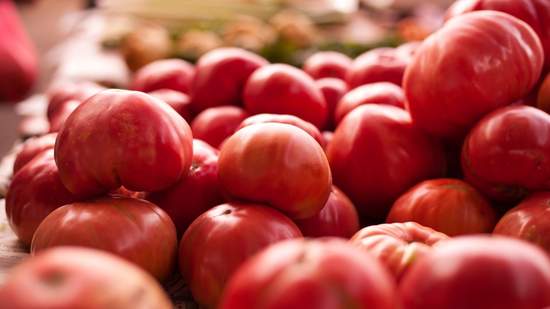Arkansas first began to adopt its own official state symbols in 1901. Many more have been adopted since then, and a state symbol can come in the form of state animals, mammals, a state bird and flower, fruits, vegetables, amphibians, nicknames, and much more.
State symbols were adopted by states to best represent them and their historical roots, and past and present successes. Like all other states, there are many Arkansas state symbols that epitomize the state.
South Arkansas Vine Ripe Pink Tomato
The Arkansas state fruit and vegetable is the South Arkansas Vine Ripe Pink Tomato (pinus). Since 1987, Arkansas has been recognizing the tomato as the official state vegetable, but the key question is whether or not tomatoes are fruits or vegetables.
This gets even weirder when you consider that Tennessee has adopted the tomato as its official state fruit (not as a vegetable)!

Fruits and vegetables are considered to be culinary terms rather than actual definitions, so, botanically speaking, tomatoes are large berries, which are fruit.
However, tomatoes are not as sweet as fruits and certain berries. Typically, tomatoes will be served as a part of a salad or other savory meal, not as a dessert.
In 1887, legal questions began to arise as to whether or not a tomato was a fruit or vegetable as it could have had serious importation and exportation implications due to a U.S. tariff law that applied to vegetables but not fruit.
In 1893, the United States Supreme Court declared that tomatoes were vegetables based on popular definition, classing them by their use, and not being used in desserts.
So, by popular definition, tomatoes are vegetables, but by scientific definition, they remain to be fruit, which is why when defining the Arkansas state fruit and vegetable, Arkansas has adopted both definitions for the South Arkansas Vine Ripe Pink Tomato, making it even more symbolic than most state fruits or vegetables!
Origins of the Arkansas Pink Tomato
It was in 1961 when the University of Arkansas, located in Fayetteville released a variety of the tomato family. The tomato was officially named the “Bradley Pink”, this tomato variant is more resilient than others, being resistant to fusarium wilt and soil-borne fungal disease.
The tomato showcased a unique pink coloration, and since then more varieties, such as the Arkansas vine ripe pink tomato were born.
Over time, the tomato became increasingly popular, which forced more grocery stores to expand to further markets.

This forced Arkansas farmers to provide red-fleshed tomatoes with thick skins to these stores as they would last longer and travel better. By the time the mid-80s rolled around, most South Arkansas farmers had completely moved on from pink varieties.
During this time period (1987), farmers and civilians of the state were ready to start promoting and regaining the popularity and reputation of the Arkansas vine-ripened pink tomato.
It all came to its final head when Governor Bill Clinton officially signed into law that the vine-ripe pink tomato became the official state fruit and vegetable of Arkansas on March 16, 1987.
In 1956, the Bradley County Pink Tomato Festival finally made its debut during a warm June in Arkansas. The event was only for one day and it gave members of Bradley County the ability to celebrate the crop and the workers who made the pink tomato a success.
Since then, events were held pretty much annually, during the same month of the year to celebrate these tomatoes. However, it is even bigger nowadays, being a week-long event that takes place every June.
The first commercially sold pink tomato was from the breed “Gulf State Market Tomato”, which was often referred to as the Gulf State. Bradley County was the origin of this specific tomato breed for almost 30 years.
Unfortunately, shortly after the 1950s, the Gulf State became susceptible to catching the disease name “Fusarium Wilt Race 1”, which damages and can even kill plants. After being experimented with different tomato varieties, the Gulf State Tomato became the Pink Shipper Tomato thanks to the U.S. Department of Agriculture.
Shortly after this, the Gulf State was crossed with a USDA-numbered line, which had resistance to Fusarium Wilt, which is when the Bradley Pink tomato came into play. Unlike the Gulf State, this pink tomato had resistance to the disease, but not for long as Race 1 quickly mutated into Race 2, killing the Bradley variant.
Around 10 years later, the “Traveler” was introduced, which was another pink tomato breed, introduced by UACES after a crack-resistance experiment. Shortly after this, it was followed by the Traveler 76.
By the mid-1980s pink tomatoes had started to gather an unfortunate reputation as being somewhat problematic. This led to regular red tomatoes rising to prominence in the commercial market. It was a fact that pink tomatoes were much more disease prone and therefore were too risky to produce in high quantities.
Nowadays, red tomatoes are still undoubtedly the most popular type, but the Bradley County pink tomatoes are incredibly popular, providing much work for Arkansas farmers, and tickling the taste buds of many around the U.S. and globally!
Final Thoughts
Most states will have their symbols showcase a relevant story, that is indicative of the state and its history, and the Natural State puts its history and what it stands for across very well in the Arkansas state fruit and vegetable.
This interesting fact about Arkansas and a whole host of others is what makes the state so unique and fascinating to those that live there or are researching the historical events and symbols of the state.


